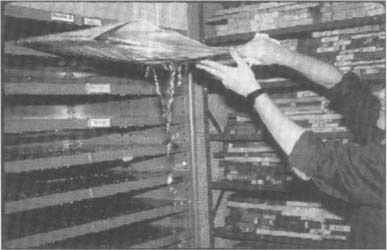
Topics in Photographic Preservation 1999, Volume 8, Article 2 (pp. 11-15)
In December 1986, a small collection of National Geographic large-format Ektachromes were damaged in a flood. They were salvaged, dried in a variety of ways, and in 1998 they were re-examined. Some residual damage that had been observed after drying was still visible, but no evidence of additional damage was detected.
At 8:30 pm on Sunday, December 14, 1986 I received a call from the security force of our Gaithersburg office. Water had been found flowing from a pipe in the ceiling of our Illustrations storage area at 2:00 that afternoon. The engineers and building maintenance men spent the afternoon stopping the leak and removing most of the water from the floor, and although they thought that damage to the photographs was minimal, the engineers had spent the last two and a half hours trying to reach the right person in the Illustrations Library. Harry in the Engineers had called Security who called Myra in the Vice President's office, and Myra called John who gave her Mike's number, and Mike gave her Bill's number, and Bill said she should call me.
When I finally got the call, I called Bill Bonner, the supervisor of that section of the Illustrations Library, and told him I was heading in. After a quick survey of the damage, I called him back. We agreed that he should come in and help me do as much salvage as possible that night, and having authorized the overtime with his supervisor, we called one of his assistants out of bed, and they joined me by about 10:30.
All that was affected was one small area of the second floor where photographic and photomechanical engraving materials were stored. The engineers had spent the afternoon removing water from the floor, not realizing how much water had intruded into the boxes and envelopes of photographs. Having dried the rug as much as possible, the engineers left at around 11:00, giving us a little more room to work. Each of more than 100 envelopes and boxes of film, ranging from two feet long up to four feet by four feet square had to be opened and checked.

Fortunately, most of boxes were dry inside, so we moved to the shelved envelopes of engravers dupes. Starting from the bottom, we began removing them from file, draining enough water so that they could be transferred downstairs to the main floor. Many of the envelopes were filled with water, increasingly so as we moved up the shelves.
Early on we realized that we would need more help the next day, and had lined up a team to come in Monday morning. I, of course (Murphy's Law), was already committed to coming to our main offices downtown to open an exhibit in our museum. We worked that first night until 2:00 am, removing all of the effected boxes and envelopes from the shelves, sorting according to condition, drying with paper towels those not wet inside the plastic covers, and writing a priority list for the next day. I documented the event with pictures and notes.
It was later determined that the water had been leaking into the library for several hours before it was discovered, and there were over a hundred gallons removed from the floor before I arrived. I made sure the rug was removed on Monday, to avoid the additional disaster of mildew. Luckily, the excellent HVAC system easily handled what was left after the floor was dry and rug removed. There was no damage on the first floor, and only about ten boxes of production films were affected.
Over 1000 engravers dupes were hit by falling water and not protected by the storage materials. Thousands more were re-examined on Monday to be sure there was no dampness, and returned to file.
In the production of some of our publications, originals are duplicated onto estar-based Ektachrome duplicating films in the exact crop and either the same size or the same ratio in which they will appear on the published page.
This process has been for the most part replaced by scanning, but we still retain many of the old “engravers dupes” or “edupes” in file. These edupes are then stored primarily for reprintings of the product or reuse in products that don't require either more image area or a better quality resolution than is possible using an edupe.
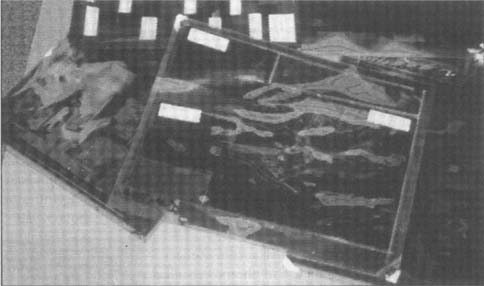
In most cases, smaller edupes are assembled into page layout format by the engravers for plate-making, and kept that way for permanent storage. The edupes are assembled using various kinds of tape, masked using another tape, and enclosed in two plastic sheets, using still another tape.
Several assemblies are then placed inside a rigid cardboard cover or a large envelope for storage.
After the book or magazine is published, depending on the contractual agreement with the photographer, the original photographs are either retained by the Geographic or returned to the photographer.
On Monday, as Bill and two others continued to sort and strip the wet engravers dupes in Gaithersburg, I started making calls and listing alternatives for drying. One contact at Kodak had recommended keeping the dupes wet until they could be re-washed and re-hardened, but our in-house photo lab said we couldn't use their processors due to the possibility of contamination, and advised against trying to harden them by hand. So the next step was to try to dry them in a way that would cause the least damage.
I returned to Gaithersburg on Tuesday, and began sorting through the dupes we had not been able to put back in file. I designated three categories of wetness: damp, where water had not seeped between the cover sheets; wet, where water had come into contact with either the base or emulsion side; and drowned, for those wet enough to swell the emulsion and/or warp the support.
Amazingly, after almost 48 hours, the scotch-type tape used on the dupes themselves came up fairly easily. I only removed the tapes if I had to, but there were lots of dupes that had to be split up. Unfortunately, after pulling tape off of hundreds of dupes, one dupe tore and became the first fatality.
On the left you see a dupe just after it was removed from the plastic covers. It is warped and puddles of water still sit in several spots. I was worried that if dried too fast or too slowly, or not under pressure or under pressure with the wrong interleaving, these dupes would never return to their original shape and the emulsion might stain or shift. I used three recommended drying techniques: blotters, heat, and air. The blotters turned out to be impractical because of lack of supplies, but space made drip-drying difficult. I finally turned on all our light tables and threw dupes on the light tables.
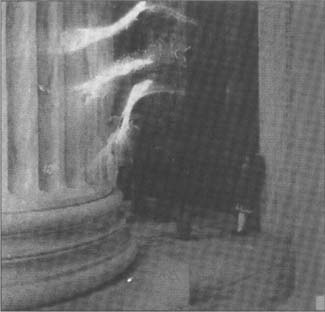
Below are three photographs of an engraver's dupe from the time it first hit the light table until it was removed.
You can see the staining start to fade as soon as the puddle dries, but then it starts to curl, so I used weights as it cooled and by the time it was cool, it was flat. I couldn't use the weights while the light table was on because both sides of the dupe were damp and I didn't want to trap moisture between the dupe and the heat source.

I tried to keep orderly records of conditions and treatments, but it was a strain to keep up. In the end, it is my descriptions of the event in memos and my lists of the photographs involved that have proved the most valuable.
I did not have time to keep track of each treatment I performed on each dupe, but only counted how many were air-dried and how many between blotters. This data is of very little use now.
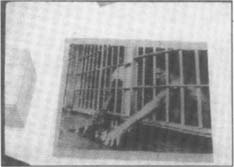
One task of record-keeping that took the most time but was the most critical was going back to the files to determine whether we had retained the original for each of the damaged dupes. Fortunately, I was able to complete almost all of the drying before having to deal with this. By Tuesday, December 23, all but 19 dupes had been dried and returned to file.
With list in hand, I checked the condition of the dupe and recorded the damage on the image's permanent file record, and also recorded the presence or lack of an original in file on the dupe list.
In some cases we have the slide, in others it has been returned and is often never available again. In the end, all 1100 records included a “Damaged” indication, and my list showed those dupes for which we had no original.
By the end of January, I had rewetted and redried the last of the damaged dupes, corrected the last record, and filed my final report.
In 1998 I pulled some of the dupes that had been the most badly wetted in 1986. This spread from National Geographic World magazine must have looked pretty bad to me because I shot a couple of photos of it at the time.
Here is the red car still between the cover sheets, and on the right after drying. I hope the halftone will show the thin tide lines around the front tire and bumper.
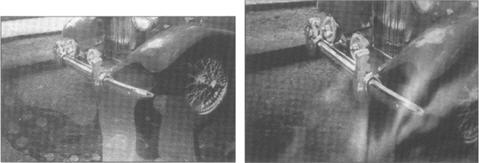
Here is the same dupe today, by transmitted and glancing light. You may be able to see a little line where the water stopped near the tire and bumper slightly visible in glancing light but not transmitted light. There are lines like those on nearly all the dupes where water migrated between the cover sheets, and also lots of particles in the emulsions, and a few scratches that may be older. However, there is no sign that the rewetting or method of drying had any negative long-term effect, such as dye instability, lack of adhesion of layers, other mechanical instability, etc.

The red car layout was not among the sixteen worst, those that I kept an additional month to work on. On this page I have tried to reproduce some of those sixteen.
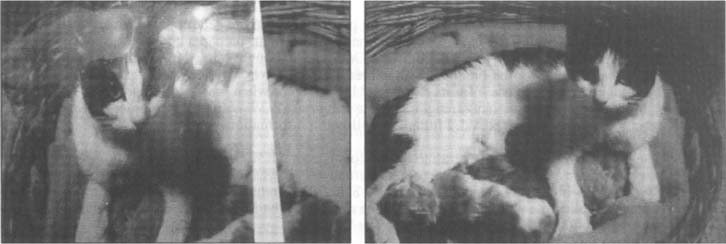
The additional bathing seems to have cleaned them up to at least the condition of the less damaged. Above left is an engraver's dupe shot with the emulsion side up to show the residual damage in glancing light. On the right, viewed right-reading and without glancing light, the damage is all but invisible. (The crack down the middle is the space between the two pieces of film, needed to produce the gutter in publication.)
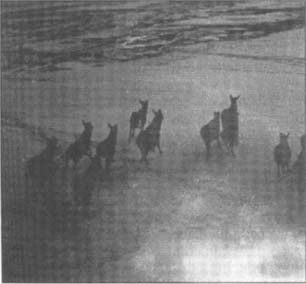
The emulsion of this engraver's dupe exhibits a few waterlines and some embedded fibers, some of which could probably still be removed today. They are clearly visible in a glancing light. However, in reproduction they are barely detectible.
In this example, although the damage is no worse than the others, because of the expanse of solid color, it will be more difficult to hide.
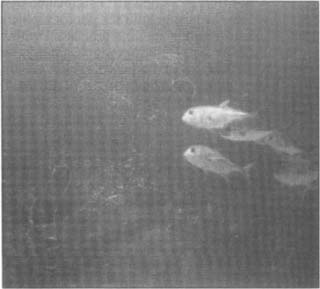
Although a hasty and incomplete salvage effort was executed following the 1986 flood, with the exception of three complete losses, all the remaining Ektachromes are currently usable and most are in excellent condition. In addition, advances in computer software in the last ten years provides us with an easy fix for the last remaining signs of the flood should we need to reproduce even the most damaged of our engraver's dupes.